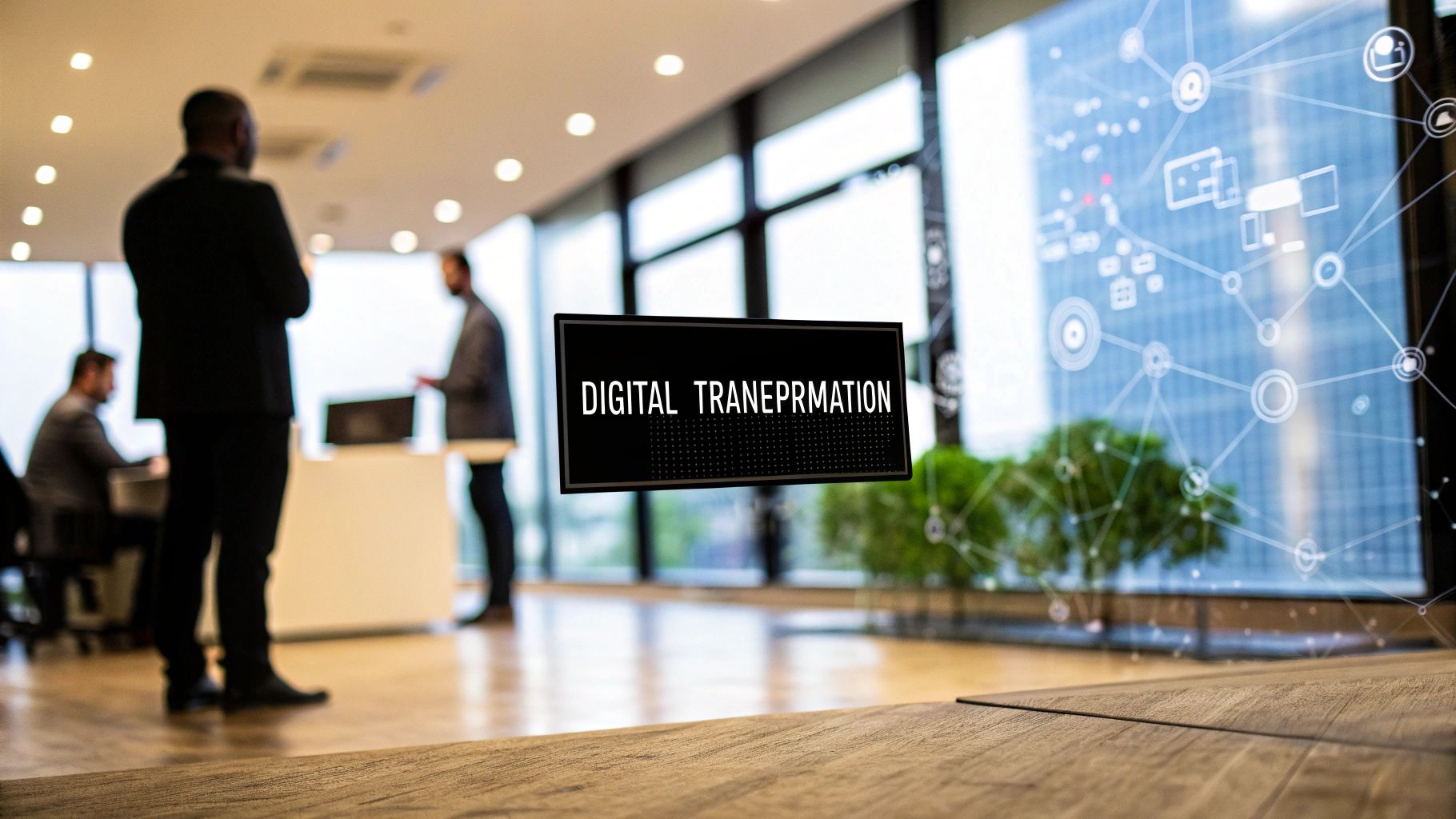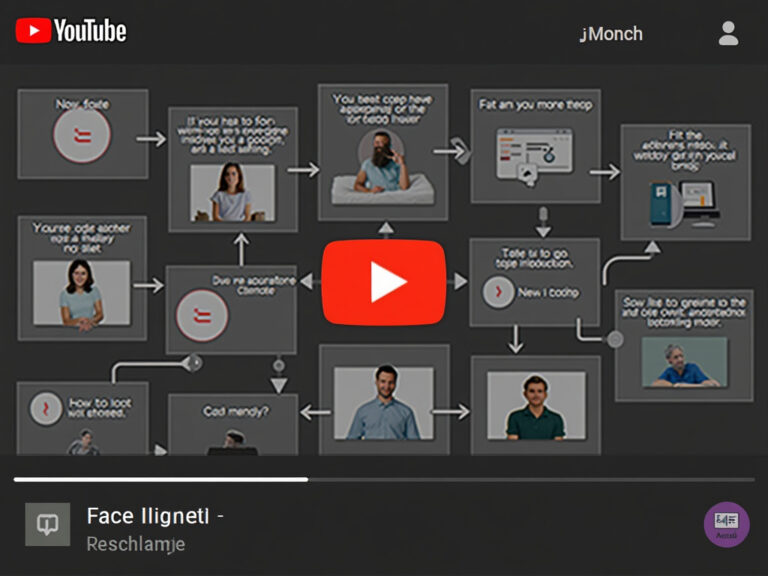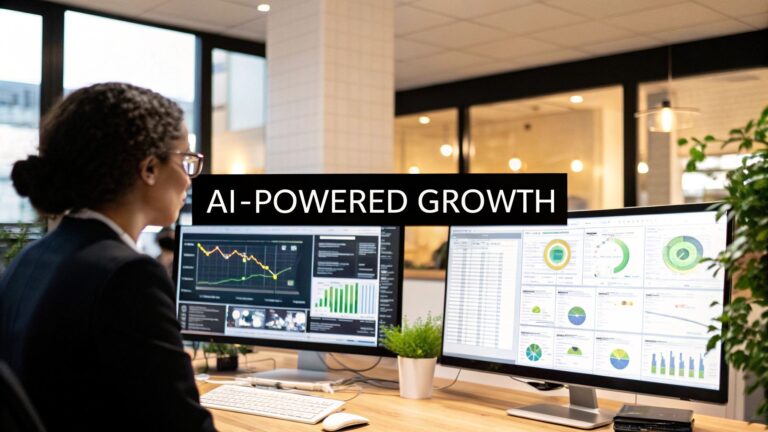What Is Digital Transformation And Why It Matters
Let's get one thing straight: digital transformation isn't just about buying new software or moving files to the cloud. It’s a complete, top-to-bottom reinvention of how your business operates, how your team works, and how you deliver value to your customers.
This is a fundamental cultural and operational shift. You're using technology not just to do things better, but to do entirely new things that weren't possible before. It’s about rethinking your entire business model to keep up with—and get ahead of—a rapidly changing market.

Unpacking What Digital Transformation Really Means
The term "digital transformation" gets thrown around a lot, often incorrectly. To really get it, you need to see it as the final stage of a much larger journey. It’s the culmination of two earlier steps: digitization and digitalization.
Let’s break this down with a simple analogy. Imagine a local bookstore back in the day.
The first step it might take is digitization—simply converting something from analog to digital. For our bookstore, this means ditching the old paper ledger and putting its entire book inventory into a digital spreadsheet. The information is now in a computer, but the core process of tracking books is essentially the same.
The Evolution From Digitization to Digital Transformation
This table clarifies the distinct stages that lead to full digital transformation, helping you understand the differences between these commonly confused terms.
| Concept | Definition | Business Example (Retail) |
|---|---|---|
| Digitization | Converting analog information into a digital format. | A clothing store scans paper receipts and saves them as PDFs. |
| Digitalization | Using digital technology to improve an existing business process. | The store implements a point-of-sale (POS) system that automatically tracks sales and inventory. |
| Digital Transformation | Fundamentally changing how the business creates value using digital tools and strategies. | The store launches a virtual try-on app and offers a personalized subscription box based on customer data. |
As you can see, each step builds on the last, moving from simple data conversion to a complete reimagining of the business itself.
The Jump To True Transformation
The next step up is digitalization, where technology is used to improve an existing process. Our bookstore sets up a basic website to sell books online. Now, when a customer buys a book, the inventory spreadsheet updates automatically. This is a big improvement in efficiency, but the store is still fundamentally just selling books.
"Digital transformation is a profound rethinking of business models, operations, and customer experiences, driven by the strategic adoption of new technologies."
Finally, we arrive at true digital transformation. This is where the magic happens. The bookstore doesn't just sell books better; it completely changes its business model to create new forms of value.
Suddenly, it’s not just a bookstore anymore. It's a digital-first community hub that now offers:
- AI-powered book recommendations to give each customer a personalized shopping experience.
- Live-streamed Q&A sessions with authors, reaching a global audience.
- Curated subscription boxes, creating a new, reliable recurring revenue stream.
- An online forum for book lovers to connect and discuss their favorite reads.
This is a whole new business, built from the ground up with digital tools at its core. This deep-seated change is what it’s all about, and it's catching on—one report found that 53% of organizations now have a company-wide strategy for it.
For smaller companies, the journey can look a bit different, often with more flexibility. You can explore those unique opportunities in our guide on digital transformation for small business. Ultimately, this strategic shift is what allows a business to not just survive, but truly thrive.
The Four Pillars of Real Transformation
A genuine digital transformation isn't a one-off project or a happy accident. It’s a deep, structural change built on four interconnected pillars. When you get the balance right, these pillars create a foundation for a business that's not just modern, but also resilient, adaptable, and genuinely forward-thinking.
Think of it like building a skyscraper. You wouldn't just install state-of-the-art smart technology and call it a day, right? You’d need solid architectural blueprints, a plan for how people will actually use the space, and a construction crew that knows how to work together. It all has to work in harmony. The exact same principle applies here.
Technology Integration
The first pillar, and the one most people think of, is Technology Integration. This isn't about just buying the latest software. It's about strategically weaving digital tools—like cloud computing, AI, and data analytics—into the very fabric of your operations. This tech becomes the engine powering everything else.
A great example is a manufacturing company placing IoT sensors on its assembly line. This isn't just a gimmick. Those sensors feed real-time data to an AI, which can then predict when a machine needs maintenance before it breaks down. That simple integration prevents costly downtime and makes the entire operation more effective.
Process Optimization
Tied directly to technology is the second pillar: Process Optimization. This means completely rethinking your workflows to be faster, smarter, and more efficient. So many businesses stumble here by simply taking an old, clunky paper-based process and making it a digital one. That’s not optimization; it’s just a digital mess.
True optimization asks, "How can these new tools let us work in fundamentally better ways?" It’s the difference between scanning a paper invoice versus building an automated accounts payable system that handles everything from receipt to payment with almost no human touch. That shift frees up your team from mind-numbing tasks and lets them focus on work that actually matters.
This visual breaks down how these core components fit together in a successful strategy.
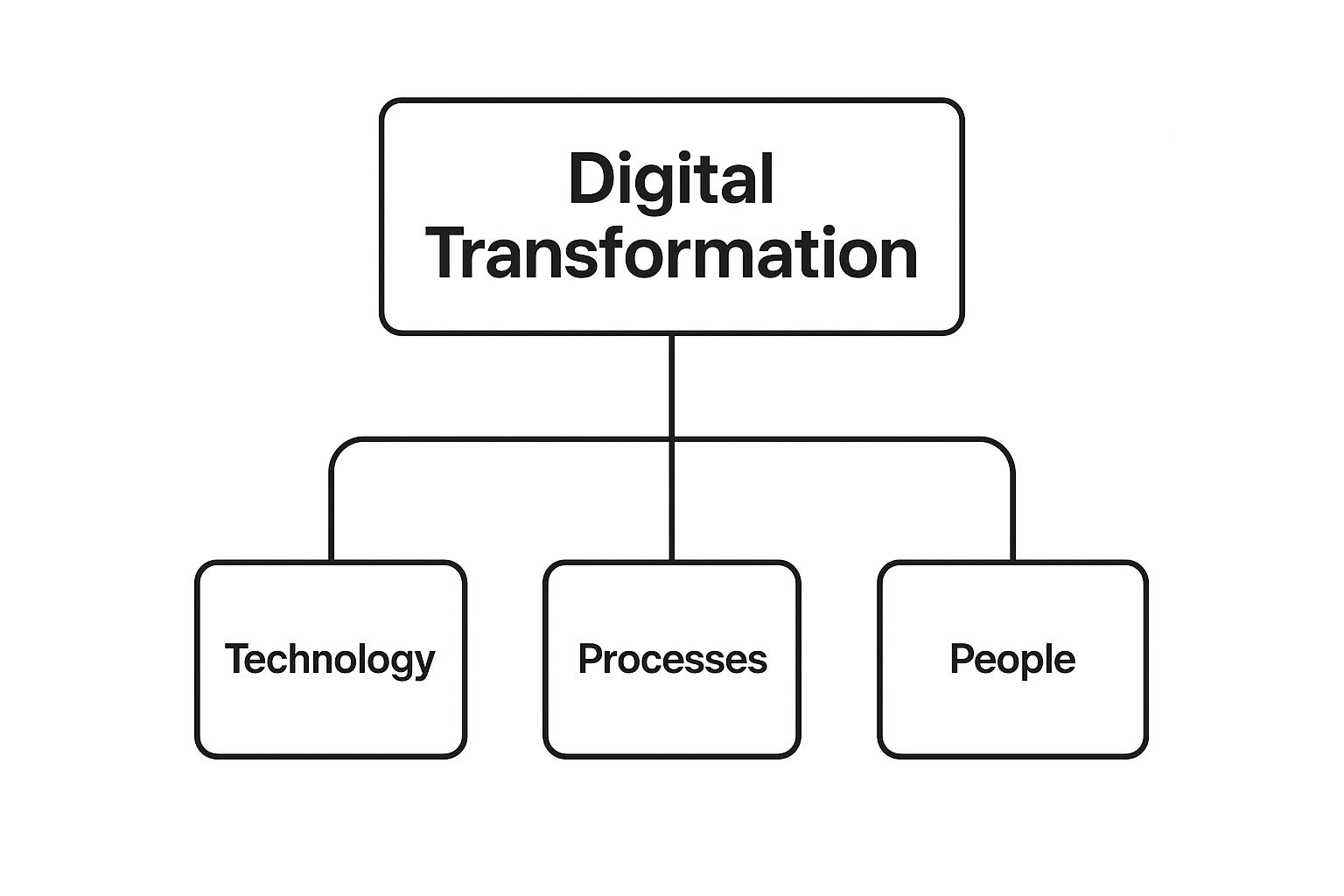
As you can see, technology and processes are the bedrock. But what really determines success is the impact on people—both customers and your own team.
Customer Experience Reimagination
That brings us to the third pillar, Customer Experience Reimagination. In today's market, you don't earn loyalty with a good product alone. It comes from creating seamless, personal, and intuitive interactions at every step. Digital tools are what make this possible at scale.
Look at how modern SaaS companies operate. They use data analytics to see exactly how people use their product, offer instant support with AI chatbots, and design personalized onboarding to help new users succeed. This data-driven approach helps them anticipate what a customer needs before they even ask, building a relationship that feels less like a transaction and more like a partnership.
Digital transformation succeeds when technology serves a clear human purpose—whether that's empowering an employee to work smarter or creating a memorable experience for a customer.
Cultural and Organizational Shift
The final, and arguably most crucial, pillar is the Cultural and Organizational Shift. This is the human side of the equation, and it's what makes or breaks any transformation effort. You can have the best tech in the world, but if your company culture resists change and learning, it will all fall flat.
This pillar is about tearing down silos between departments, fostering real collaboration, and giving employees the freedom to experiment and innovate. It requires leaders who champion a growth mindset, where mistakes aren't punished but are seen as valuable lessons. Companies that nail this, like Microsoft under Satya Nadella, understand that true transformation always begins and ends with its people.
Why Staying the Same Is No Longer an Option
In today’s market, clinging to old ways of doing business is like trying to navigate a superhighway with a horse and buggy. The world has simply moved on. What was once a forward-thinking strategy for getting ahead—digital transformation—is now the bare minimum for survival. The question isn't if your business should transform, but how and how fast.

The pressure to adapt is coming from all sides, fueled by sky-high customer expectations and a constant stream of disruptive technologies. Companies that drag their feet don't just risk falling behind; they risk becoming completely irrelevant.
Driving Operational Efficiency and Savings
One of the first and most concrete wins from a smart transformation is a major jump in operational efficiency. This isn’t about just doing old processes faster; it's about fundamentally rethinking how work gets done in a digital-first world.
Take intelligent automation, for instance. It can handle the repetitive, mind-numbing tasks that bog down your team, like data entry, processing invoices, or answering basic support questions. This move accomplishes two critical things:
- It slashes human error, which means higher quality and more reliable results.
- It frees up your team to focus on the strategic, creative work that actually drives the business forward.
This newfound efficiency leads directly to real cost savings, better productivity, and a more motivated team. Instead of being stuck in the weeds of manual work, your people are empowered to innovate.
Empowering Data-Driven Decision Making
Not too long ago, many business decisions were made on gut feelings, past experience, or historical data that was already weeks out of date. In today's fast-moving environment, that's a recipe for disaster.
By integrating your systems and embracing analytics, you get a live, real-time view of what's happening across your entire operation. This allows leaders to trade guesswork for strategic confidence.
When you have a clear, up-to-the-minute view of performance metrics, customer behavior, and market trends, you can make smarter decisions, faster. That agility is what helps you pounce on new opportunities and fix small problems before they become big ones.
This cultural shift toward relying on data is what makes a modern business truly resilient and responsive.
Redefining the Customer Experience
Modern customers expect everything to be seamless, personalized, and instant. They want companies to anticipate their needs and solve their problems with almost no effort on their part. Digital transformation is what gives you the toolkit to meet—and even exceed—these demands.
From AI-powered chatbots providing 24/7 support to marketing campaigns tailored to individual user behavior, technology lets you build a customer journey that feels completely intuitive. This intense focus on the customer experience doesn't just keep people happy; it builds fierce, lasting loyalty and turns customers into your biggest fans.
Global spending on digital transformation is on track to hit nearly $4 trillion, with North America making up 43% of that market. But here’s the tough part: only about 35% of these projects actually hit their goals. This statistic screams just how vital a solid strategy is—in fact, following best practices can triple your chances of success, no matter where you are. You can get more information about data transformation challenge statistics and discover more insights on how to improve outcomes.
At the end of the day, businesses that don't adapt are left trying to play a game where the rules have fundamentally changed. The choice isn't between staying put or evolving—it's between transforming and fading away.
Key Technologies Powering Business Innovation
Technology is the engine of any real digital transformation, but it’s not about chasing every shiny new object. True innovation comes from a handful of core technologies that fundamentally change how a business works, grows, and serves its customers.
These aren't just minor upgrades; they represent a whole new way of thinking about your data, your infrastructure, and your company's intelligence. When you bring them together thoughtfully, they become the building blocks for a more nimble, insightful, and tough-as-nails organization that can thrive in a constantly changing market.
Cloud Computing: The Flexible Foundation
At the heart of almost every modern business, you’ll find Cloud Computing. Think of it as the launchpad for everything else you want to do digitally. It frees you from the headache and expense of managing your own physical servers, giving you on-demand access to computing power, storage, and a whole suite of services over the internet.
This flexibility is a game-changer. It lets companies scale up or down almost instantly, paying only for the resources they actually use. A B2B SaaS company, for example, can go from serving ten customers to ten million without having to build its own expensive data centers. That kind of agility is essential for survival and growth.
Artificial Intelligence And Machine Learning
If the cloud is the foundation, then Artificial Intelligence (AI) and Machine Learning (ML) are the brains of the operation. These technologies give your systems the ability to learn from data, spot patterns, and make smart predictions or decisions with very little human input. They’re how you unlock a whole new level of operational intelligence.
The uses are endless and are already making a huge difference:
- Predictive Analytics: AI can sift through past customer behavior to give you a surprisingly accurate forecast of future trends, which helps you nail your inventory and marketing budgets.
- Intelligent Automation: You can hand off all the boring, repetitive tasks to AI, freeing up your team to focus on work that actually requires a human brain.
- Personalization: ML algorithms can craft unique experiences for every customer, from tailored product recommendations to user interfaces that adapt on the fly.
The combination of AI and workflow automation is especially powerful, leading to innovations like AI powered workflow automation that can completely overhaul business processes. To get a better handle on one specific type of automation, you can learn more about what is robotic process automation and see how it fits into the bigger picture.
Big Data And Analytics
Businesses today are swimming in data. It’s pouring in from customer chats, social media, internal systems—you name it. On its own, though, all that data is just noise. Big Data and Analytics are the tools that help you turn that noise into your greatest strategic asset by collecting, processing, and analyzing huge datasets to find the hidden gold.
A B2B software company can use analytics to see exactly which features users love and which ones are causing headaches, allowing them to make product improvements based on hard evidence instead of just a gut feeling.
"Data is the new oil. It’s valuable, but if unrefined it cannot really be used. It has to be changed into gas, plastic, chemicals, etc. to create a valuable entity that drives profitable activity; so must data be broken down, analyzed for it to have value."
– Clive Humby, Data Science Pioneer
The Internet of Things
Finally, the Internet of Things (IoT) connects the physical world to the digital one. It's a massive network of physical devices—everything from factory machines to delivery trucks—that are equipped with sensors and software, allowing them to talk to each other and share data over the internet.
This constant flow of real-world data opens up incredible opportunities for optimization. A logistics company, for instance, can use IoT sensors in its fleet to track a truck’s location, monitor engine health, and fine-tune fuel consumption in real time. The result? Huge cost savings and happier customers.
As leaders push forward, their priorities are becoming clear. By 2025, research shows 72% of organizations have adopted cloud-native platforms, and 71% are using Infrastructure-as-a-Service (IaaS). Generative AI is also taking off, with one in five organizations already scaling it up. The biggest roadblock? Finding the right people. A massive 90% of organizations say they're struggling with a skills gap. You can discover more insights from the 2025 State of Digital Transformation report to get the full picture.
A Practical Framework for Your Transformation Journey
Starting a digital transformation can feel like trying to change a tire on a moving car. It's complex, a little scary, and the stakes are high. To avoid getting overwhelmed, the most successful companies don't just dive in; they follow a clear, structured framework.
This isn't about a rigid, one-size-fits-all checklist. Instead, think of it as a logical roadmap that breaks a massive undertaking into a series of manageable, value-driven steps. It helps you build momentum, learn as you go, and keep every initiative tied to your core business goals.
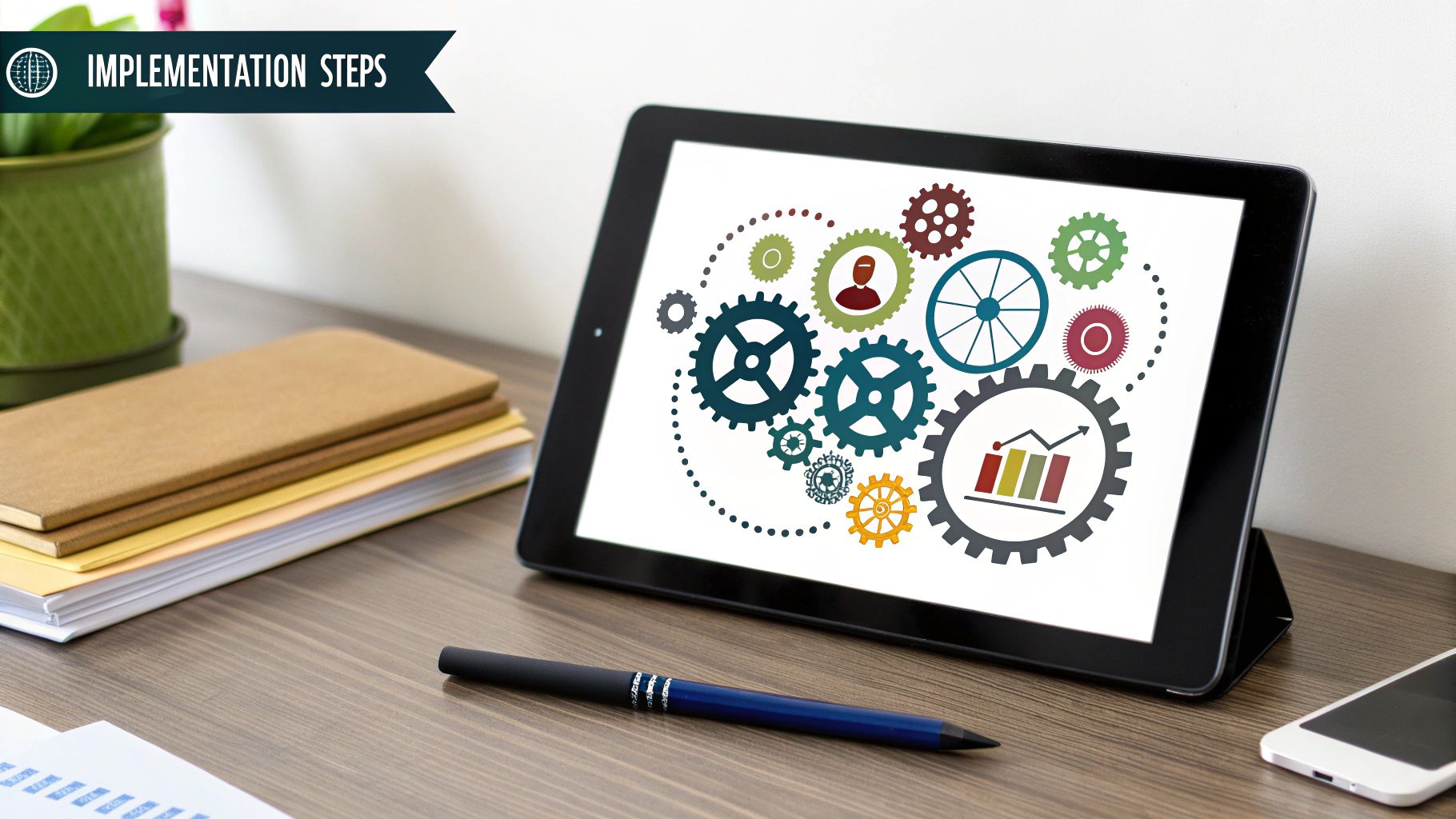
Phase 1: Define Your Vision and Get Everyone on Board
Before you even think about new software or tech, you have to start with a clear, compelling vision. What does a "win" look like for your company in a digital-first world? This needs to be more than a vague mission statement; it has to be a powerful story about where you're going and, crucially, why it matters.
This story is your single most important tool for getting buy-in from leadership. Without their unwavering support, even the best plans die on the vine, starved of resources or derailed by competing priorities. Your vision has to connect directly to real business outcomes, making it obvious that this is a strategic imperative, not just another IT project.
Phase 2: Take an Honest Look in the Mirror
With your vision set, it’s time for a reality check. You need to conduct a brutally honest assessment of where your business stands today. This means digging into your current technology, daily workflows, and even your company culture. The goal is to find both the roadblocks holding you back and the hidden strengths you can build on.
Your audit should answer a few key questions:
- Technology Gaps: What clunky, outdated systems are causing bottlenecks or killing innovation?
- Process Inefficiencies: Where are manual tasks and repetitive workflows burning time and money?
- Cultural Readiness: Does your team have the skills—and the mindset—to actually embrace this change?
This assessment gives you the facts you need to build a realistic strategy. It grounds your ambitious vision in the reality of your starting point.
Phase 3: Build Your Strategic Roadmap
This is where you connect the dots between your vision (where you want to go) and your assessment (where you are now). The result is your strategic roadmap—a prioritized plan with specific projects, timelines, and measurable goals.
The key here is not to boil the ocean. Don't try to do everything at once. Instead, focus on a handful of high-impact projects that will deliver tangible results quickly. A smart roadmap sequences these projects logically, letting early wins build momentum and even help fund bigger, more ambitious initiatives down the line. Streamlining internal operations is often a great place to start, and you can learn more about how to automate business processes to find some of those quick wins.
A roadmap is a compass, not a GPS. It provides direction and clarity but should be a living document you can adjust as you learn and as the market shifts.
Phase 4: Pilot, Test, and Learn Fast
Before you commit to a massive, company-wide rollout, you absolutely must run a pilot program. Think of it as a controlled experiment. Pick a small, focused group or a single department to test your new idea in a real-world setting.
This approach gives you two massive advantages. First, you get to find and fix all the inevitable bugs and hiccups on a small scale, where the stakes are low. Second, a successful pilot creates powerful proof that this new way works, turning those initial users into internal champions who will help you drive wider adoption. This "start small, learn fast" mindset is the secret to minimizing risk.
Phase 5: Scale Up and Never Stop Improving
Once your pilot is a proven success and you’ve ironed out the kinks, it's time to scale. This means methodically rolling out the solution across the rest of the organization. But the job isn't done when the rollout is complete.
True digital transformation isn’t a project with an end date; it's a permanent commitment to continuous improvement. This final phase is all about weaving this new way of working into your company's DNA. You have to create feedback loops, watch your performance metrics, and always be on the lookout for the next opportunity to optimize and innovate. This creates a resilient culture where change is normal, ensuring your business doesn't just transform once—it stays transformed.
To help visualize this journey, here’s a simple template outlining what each phase looks like in practice.
Digital Transformation Roadmap Template
This table breaks down the entire process into actionable stages, helping you track progress and stay focused on what matters most at each step.
| Phase | Primary Goal | Key Activities | Success Metric |
|---|---|---|---|
| 1. Vision & Buy-In | Align leadership around a clear, strategic direction. | Conduct stakeholder workshops, define business outcomes, and create a compelling vision narrative. | Executive team signs off on the vision and formally commits resources. |
| 2. Current State Assessment | Understand existing capabilities, gaps, and opportunities. | Audit technology stack, map key processes, survey employees on cultural readiness. | A detailed report identifying top 3-5 strategic priorities is complete. |
| 3. Roadmap Development | Create a prioritized, actionable plan. | Identify pilot projects, define project scope, set timelines and budgets, and establish KPIs. | A formal roadmap is approved with clear ownership and quarterly goals. |
| 4. Pilot Testing | Validate a new solution on a small scale to minimize risk. | Select a pilot group, deploy the new technology/process, and gather feedback. | Pilot achieves >80% of its target KPIs; positive feedback from users. |
| 5. Scale & Improve | Implement the solution across the organization and foster a culture of continuous optimization. | Develop a full rollout plan, provide training, monitor adoption, and iterate based on data. | 90% of the target user base is actively using the new system; ongoing improvements are documented. |
Using a structured roadmap like this turns an intimidating challenge into a series of achievable milestones, paving the way for a successful and sustainable transformation.
Charting Your Course for Lasting Change
Think of digital transformation less as a destination and more as a journey. There’s no finish line to cross, just a continuous process of adapting and getting better. We’ve covered what digital transformation really means, why it’s no longer optional, and the core building blocks that make it happen.
If you remember just one thing, let it be this: think big, but start small. Your ultimate goal might be a top-to-bottom overhaul, but the real work begins with a single, well-chosen step.
From Vision to Value
It’s tempting to try and fix everything at once, but that's a classic mistake. Instead, pour your initial energy into a project that can deliver real, measurable results quickly. These early victories are incredibly powerful—they build momentum, demonstrate the value of what you're doing, and get your teams genuinely excited for the road ahead.
What does a good first project look like? It could be something as simple as automating a repetitive, soul-crushing task in your finance department. Or maybe it’s setting up a basic CRM to finally get a handle on customer conversations. These focused efforts act as a proof-of-concept, making it much easier to get the green light for bigger, more ambitious projects later on.
Technology is just the vehicle. The real change happens when you empower your people, rethink your processes, and put the customer at the absolute heart of every single decision.
Your Next Steps
The framework we discussed earlier is your compass. Use it to start mapping out your initial moves today. Begin by defining what success actually looks like for your business, take an honest look at where you are right now, and pinpoint one or two pilot projects that can make an immediate impact.
Keep these principles front and center:
- Start with Why: Be crystal clear about the business problem you're trying to solve.
- Focus on People: Give your team the training, tools, and support they need to succeed.
- Measure Everything: If you can't measure it, you can't improve it. Track key metrics to see what’s working.
By taking an agile, step-by-step approach, you can navigate the inevitable twists and turns of this journey. You’ll build an organization that’s not just more efficient, but more resilient and ready for whatever comes next.
Frequently Asked Questions
Got questions about digital transformation? You're not alone. Let's clear up some of the most common points of confusion so you can move forward with a solid understanding.
What Is the Difference Between Digitization, Digitalization, and Digital Transformation?
It's really easy to get these terms mixed up, and you’ll often hear people use them interchangeably. But they actually represent three very different stages of technological adoption. Think of it like a ladder—each step builds on the one before it.
-
Digitization: This is the ground floor. It's the simple act of converting something from a physical, analog format into a digital one. Scanning a paper document and saving it as a PDF? That’s digitization.
-
Digitalization: Now you're climbing a rung. Digitalization is about using that digital information to make an existing process work better. Instead of just scanning an invoice, you might use an online form and an automated system to handle your entire accounts payable process. You're improving how you work.
-
Digital Transformation: This is the top of the ladder, a complete change in perspective. It's not about tweaking a single process; it's a fundamental rethinking of your entire business—your strategy, your model, your culture—powered by digital tools. It touches every part of the company, from how you operate internally to how you connect with customers.
How Long Does a Typical Digital Transformation Project Take?
There’s no one-size-fits-all timeline. That’s because digital transformation isn’t really a "project" with a clear start and finish line. It’s much more of an ongoing journey of continuous improvement.
That said, you can absolutely expect to see tangible results from your first big initiatives within 6 to 18 months. The real win, though, is building a culture where change becomes normal. When adapting and improving is just part of how you operate, you’re set up for long-term success.
The smartest way to approach this is in manageable phases. Don't try to boil the ocean. Focusing on gradual, deliberate changes gives your team time to learn, adapt, and actually embrace the new way of doing things.
What Is the Biggest Challenge in Digital Transformation?
You might think it’s the technology, but it’s almost always the people. The biggest hurdle is getting your team to break old habits and embrace a new way of working.
Overcoming resistance to change, upskilling your employees, and getting genuine buy-in from leadership all the way down—that’s the hard part. You can have the best tech stack in the world, but without a culture that’s open to learning and experimentation, it will fall flat. True transformation requires leaders who champion change and empower their teams to evolve.
Can Small Businesses Undergo Digital Transformation?
Absolutely. In many ways, small businesses have the upper hand. They're usually more nimble and can pivot much faster than a massive, layered corporation. The principles are exactly the same, just applied on a different scale.
For a smaller company, transformation could be as straightforward as:
- Switching to cloud-based accounting software to get a better handle on finances.
- Implementing a simple CRM to build stronger customer relationships.
- Using an e-commerce platform and social media marketing to tap into new markets.
It's all about using technology strategically to solve your biggest problems and unlock growth. Size doesn't matter; mindset does.
Ready to stop wasting time on manual tasks and start building a more efficient, scalable business? At MakeAutomation, we specialize in creating custom AI and automation frameworks that help B2B and SaaS companies accelerate their growth. Book a free consultation today to discover how we can help you implement the right digital solutions for your business.

